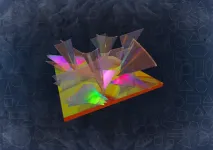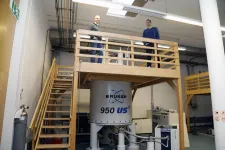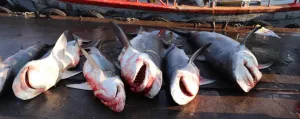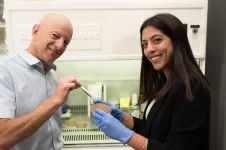(Press-News.org) In 1884, Edwin Abbott wrote the novel Flatland: A Romance in Many Dimensions as a satire of Victorian hierarchy. He imagined a world that existed only in two dimensions, where the beings are 2D geometric figures. The physics of such a world is somewhat akin to that of modern 2D materials, such as graphene and transition metal dichalcogenides, which include tungsten disulfide (WS2), tungsten diselenide (WSe2), molybdenum disulfide (MoS2) and molybdenum diselenide (MoSe2).
Modern 2D materials consist of single-atom layers, where electrons can move in two dimensions but their motion in the third dimension is restricted. Due to this 'squeeze', 2D materials have enhanced optical and electronic properties that show great promise as next-generation, ultrathin devices in the fields of energy, communications, imaging and quantum computing, among others.
Typically, for all these applications, the 2D materials are envisioned in flat-lying arrangements. Unfortunately, however, the strength of these materials is also their greatest weakness - they are extremely thin. This means that when they are illuminated, light can interact with them only over a tiny thickness, which limits their usefulness. To overcome this shortcoming, researchers are starting to look for new ways to fold the 2D materials into complex 3D shapes.
In our 3D universe, 2D materials can be arranged on top of each other. To extend the Flatland metaphor, such an arrangement would quite literally represent parallel worlds inhabited by people who are destined to never meet.
Now, scientists from the Department of Physics at the University of Bath in the UK have found a way to arrange 2D sheets of WS2 (previously created in their lab) into a 3D configuration, resulting in an energy landscape that is strongly modified when compared to that of the flat-laying WS2 sheets. This particular 3D arrangement is known as a 'nanomesh': a webbed network of densely-packed, randomly distributed stacks, containing twisted and/or fused WS2 sheets.
Modifications of this kind in Flatland would allow people to step into each other's worlds. "We didn't set out to distress the inhabitants of Flatland," said Professor Ventsislav Valev who led the research, "But because of the many defects that we nanoengineered in the 2D materials, these hypothetical inhabitants would find their world quite strange indeed.
"First, our WS2 sheets have finite dimensions with irregular edges, so their world would have a strangely shaped end. Also, some of the sulphur atoms have been replaced by oxygen, which would feel just wrong to any inhabitant. Most importantly, our sheets intersect and fuse together, and even twist on top of each other, which modifies the energy landscape of the materials. For the Flatlanders, such an effect would look like the laws of the universe had suddenly changed across their entire landscape."
Dr Adelina Ilie, who developed the new material together with her former PhD student and post-doc Zichen Liu, said: "The modified energy landscape is a key point for our study. It is proof that assembling 2D materials into a 3D arrangement does not just result in 'thicker' 2D materials - it produces entirely new materials. Our nanomesh is technologically simple to produce, and it offers tunable material properties to meet the demands of future applications."
Professor Valev added: "The nanomesh has very strong nonlinear optical properties - it efficiently converts one laser colour into another over a broad palette of colours. Our next goal is to use it on Si waveguides for developing quantum optical communications."
PhD student Alexander Murphy, also involved in the research, said: "In order to reveal the modified energy landscape, we devised new characterisation methods and I look forward to applying these to other materials. Who knows what else we could discover?"
INFORMATION:
UK landowners and conservationists welcome wider-spread use of Gene Conservation Units (GCUs) to help protect some of the rarest plants and insects, research at the University of York has shown.
In particular the Great Yellow Bumblebee and the Mountain Ringlet Butterfly, which are at risk of further population decline, would benefit from Gene Conservation Units, currently only employed for forest trees and agricultural species or their relatives.
Genetic diversity in these species is essential if they are to adapt to new, and often challenging, environmental conditions. Gene Conservation Units are areas of land managed to allow the recovery of species, and maintain evolutionary processes to enable them to adapt to environmental change.
For tree species, ...
FRANKFURT. When the SARS-CoV-2 virus mutates, this initially only means that there is a change in its genetic blueprint. The mutation may lead, for example, to an amino acid being exchanged at a particular site in a viral protein. In order to quickly assess the effect of this change, a three-dimensional image of the viral protein is extremely helpful. This is because it shows whether the switch in amino acid has consequences for the function of the protein - or for the interaction with a potential drug or antibody.
Researchers at Goethe University Frankfurt and TU Darmstadt began networking internationally from the very start of the pandemic. Their goal: to describe the three-dimensional structures ...
Thousands of sharks have been illegally caught in a Marine Protected Area (MPA) in the Indian Ocean, new research shows.
The MPA was created in 2010 around the Chagos Archipelago, also known as the British Indian Ocean Territory (BIOT), banning all fishing there.
The new study examined information on illegal fishing in the MPA - a vast (640,000 km²/250,000 mi2) area containing pristine and remote reefs.
Enforcement data suggests more than 14,000 sharks were caught in the MPA from 2010-20, but discussions with fishers in the region suggest the true number was "considerably ...
BEER-SHEVA, Israel May 10, 2021 - Researchers from Ben-Gurion University (BGU), together with American and German colleagues, have developed new "molecular tweezers" to combat antibiotic-resistant bacteria. Their recently announced findings were published in Cell Chemical Biology.
For years, medical professionals have struggled with bacterial infections becoming increasingly resistant to antibiotics. These molecular tweezers may be the key to battling one of greatest public health issues of the 21st century.
"Our discovery prevents infection without building up antibiotic resistance, and it might even be preferable to develop treatments based on molecular tweezers rather than antibiotics," said BGU Department of Chemistry Prof. Raz Jelinek.
The research team, led ...
Bamboo cricket bats are stronger, offer a better 'sweet spot' and deliver more energy to the ball than those made from traditional willow, tests conducted by the University of Cambridge show. Bamboo could, the study argues, help cricket to expand faster in poorer parts of the world and make the sport more environmentally friendly.
"The sound of leather on willow" may have delighted cricket lovers for generations but the sport should now consider making the blades of its bats with bamboo, say researchers from Cambridge's Centre for Natural Material Innovation. ...
A group of UK academics are calling for targets for mental health in order to meet the healthcare challenges of the next decade.
Published today in Journal of Mental Health researchers set out four overarching goals that will speed up implementation of mental health research and give a clear direction for researchers and funders to focus their efforts when it comes to better understanding the treatment of mental health.
The treatment of mental illness currently brings substantial costs to not only the NHS, but also to the individual and wider society, and the need for innovation to promote good mental health has never ...
New research being presented at the European Congress on Obesity (ECO) held online this year, suggests that among girls a low body mass index (BMI) during childhood indicates a higher risk of developing anorexia nervosa as young adults, whereas a high BMI or overweight in childhood indicates a higher risk of bulimia nervosa.
"By examining the records of thousands of girls over their lifetime in national health registers, we have discovered early warning profiles that could signal girls at risk for anorexia nervosa and bulimia nervosa", says lead author Dr Britt Wang Jensen ...
New research being presented at The European Congress on Obesity (ECO) held online this year, suggests that a measure of body shape should be used alongside body mass index (BMI) to help determine the risk of obesity-related cancers.
BMI is a simple way of measuring body fat from the weight and height of a person. But its reliability is often criticised, because it does not distinguish fat from muscle, or take into account where body fat is stored or an individual's sex or age. Similarly, waist circumference takes into account belly fat, which is linked to several health risks ...
Obesity increases the risk of developing 10 of the most common cancers, regardless of how it is measured, according to a study of more than 400,000 adults in the UK, being presented at The European Congress on Obesity (ECO) held online this year, with central fatness (larger waist and hips) and general obesity (body mass index [BMI] and body fat percentage) associated with similar estimates of cancer risk.
The results suggest that BMI is an adequate measure of cancer risk from excess weight, and there is no advantage in using more complicated or expensive measures such as waist circumference or body fat percentage.
It is well known that being overweight or obese is linked to an elevated risk of some cancers and premature ...
A study of more than 173,000 women in Denmark, presented at the European Congress on Obesity (ECO) held online this year, suggests that girls with a higher body mass index (BMI) during childhood are less likely than their peers with a lower BMI to develop breast cancer as adults, both before and after the menopause.
The findings contrast with those for adult BMI, which indicate that women who gain weight after menopause have an increased risk of postmenopausal breast cancer. While the authors are unsure why children with a higher BMI appear to be protected ...





